Boiling all, or how to choose a boiler and how to install it
This article is about how to choose a boiler for the house. In it, I will talk about the advantages and disadvantages of flow and storage heaters and options that you should pay attention to when buying a device. Will be affected and installation instructions for both types of electrical appliances.
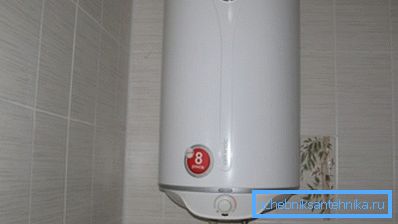
Electric or gas
To begin, we will find out which heater is better - gas or electric.
And here we will inevitably encounter the division of one more feature - flow and storage heaters. We will not hurry with the comparison of those and others; instead, I’ll talk about the merits of gas and electricity in each category.
Flow through
The electric flow heater creates a huge wiring load. The minimum power of these devices - 3.5 KW, which allows you to connect them to a conventional electrical outlet. At the same time, this power is barely enough to allow you to take a shower in the summer heat with minimal water consumption.
By the way: in this case, the wiring is still subject to very serious requirements. I would advise to use copper wire with a cross section of 2.5 mm2. The price for under-sectioning is overheating of the wiring (primarily at the terminals) and a high probability of fire.
The maximum power of the flow heater is 24 KW. These devices are connected to the shield with a separate wire and require the presence of 380 volts in the house.
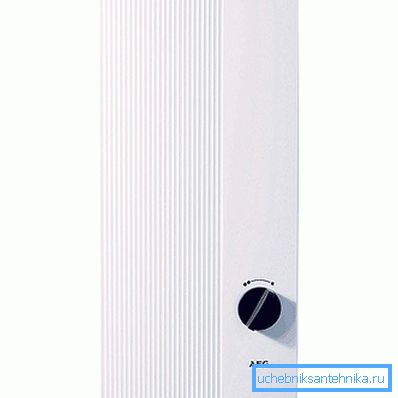
A geyser with piezo ignition may not be connected to the mains at all, with digital control and electrical ignition - consumes a few watts.
Another important point - operating costs. Here, too, appears a disappointing picture for electricity.
| Heat source | Cost of 1 kWh heat |
| Natural gas | 0.7 ruble |
| Electricity | 4 rubles |
Note: I quoted actual prices for Russia as of June 2016. Over time, their ratio may change.
However, in favor of electricity, you can also bring very convincing arguments:
- Gas is not everywhere;
- Gas equipment is significantly more expensive due to the more complex design;
- Gas requires high ventilation performance and free air flow into the room;
- Finally, the electric flow heater is more convenient in that it maintains a more stable temperature. Automatic gas heater begins to regulate the flame of the burner at the slightest change in water pressure and makes it rather awkwardly. As a result, an attempt to take a shower results in a continuous battle with taps and alternate streams of boiling water and ice water.
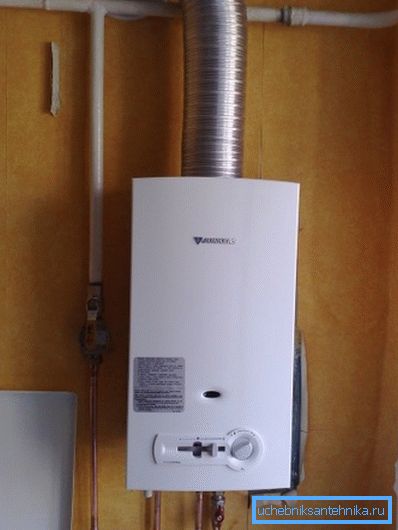
Accumulative
The accumulative gas heater is completely devoid of the last drawback: the outlet water temperature is always stable. Prices for gas boilers of well-known manufacturers (Ariston, Baxi, etc.) start at about 20,000 rubles.
A special case
If you have already installed a gas boiler (even if it is single-circuit), a simple modification of the heating system will allow you to use a cumulative indirect heating boiler. The heat source in it is the coolant passing through the internal heat exchanger; in summer, it circulates between the boiler and the boiler, bypassing the heating system. This option will be the most economical and reasonable.
Flow or accumulative
What is better - a boiler or column (instantaneous water heater)?
Geyser - in all respects the worst of decisions. I have already mentioned the extreme instability of the outlet temperature. Believe me, using such a device is more than uncomfortable.
A flow-through electric heater with a constant pressure of water gives a constant outlet temperature, since a constant power is supplied to it. However, the possibility of precise temperature control is minimal.
For this purpose is used:
- Step change power. In particular, the Atmor Basic installed in my attic floor can operate with a capacity of 1.5, 2 and 3.5 kW. In practice, a power of less than 3.5 kW is useful only at the peak of heat, when water from the cold-water supply line enters the house already warmed up to 20 degrees or more;
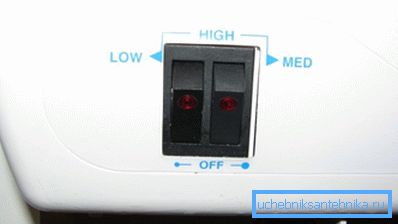
- Head adjustment. The more water passes through the heat exchanger per unit of time, the lower its temperature.
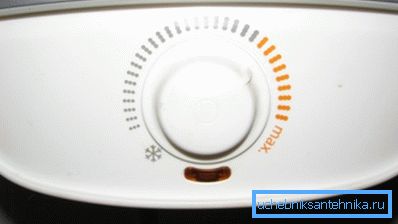
Serious load on the wiring I have already mentioned. Power over 10 - 12 kW input into the house will provide far from everywhere; But in the house without gas, in addition to the flow-through heater, there are other serious consumers - a stove, microwave, kettle, etc.
With a small power flow heater has a very moderate performance. It is comfortable to take a shower with the use of appliances that consume 5 or more kW. Simultaneous maintenance of two points of water pumping requires the installation of an in-line device (installed in the water line rupture) with a capacity of 7,000 watts or more.
But on the side of flow heaters there are several undeniable advantages:
- Compactness. A small box with heaters and a miniature flow tank takes almost no space;
- The small weight allowing to install the heater on a light partition from plywood or HL. For a boiler with a solid net weight that can hold 30 to 150 liters of water, a capital wall is needed;
- Simple installation, allowing you to bring the heater into working condition with your own hands in a few minutes. I will tell about it in the corresponding section of the article;
- Finally, the main thing: the flow-through device spends electricity only to heat the water that you are currently using. It does not keep it constantly heated, which excludes non-target losses of heat and, accordingly, electricity.
The boiler continuously dissipates heat through the insulation; as a result, from 1 to 3 kWh per day is spent only on compensation for losses.
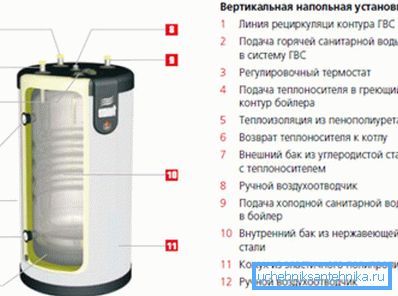
I decided for myself the problem of choice as follows:
- The bathroom of the first floor has a cumulative heater from the Ukrainian company Atlantic with a volume of 80 liters, which allows you to take a shower with maximum comfort and provides kitchen sink and a washbasin with hot water;
- In the attic floor, which is empty for part of the year, the Atmor Basic flow heater with a capacity of 3.5 kW is installed.
Options
With a meaningful purchase, the choice of a particular device is determined by studying the innumerable options offered by the manufacturer. What you should pay attention to?
I will not sort the options by type of heater and list them in the order in which I remember.
Pressure and non-pressure
This characteristic applies only to flow devices:
- Non-pressure heater serves only one point of water pumping. It connects to the cold water supply after the valves and control valves; a shower hose or a gander is installed at the outlet;
- Pressure device is placed in the water line break. This makes it possible to hide it in a cabinet and use several points at the same time (of course, with sufficient electrical power).

I chose the first option - simply because in the attic floor, hot water is needed only at one point of dismantling.
Upper and lower liner
Which boiler to choose - from the top or bottom of the water supply?
- When wall mounted above the plumbing, it is more convenient lower liner;
- The top is useful when installing the boiler in the cabinet (for example, under the kitchen sink).
Note: the upper liner is completed only boilers up to 30 liters. Thoughtful search for instruments of at least 50 liters did not bring any result: it seems they simply do not produce them.
Vertical and horizontal
Which boiler is better - with a vertical or horizontal tank?
Everything is determined by the size and layout of the room in which the heater is supposed to be installed:
- A horizontal tank is convenient in a small bathroom or kitchen. It is mounted under the ceiling and does not occupy a useful place, allowing you to place under it cabinets and wall shelves. The only drawback of such a scheme is in the liners stretching along the wall;
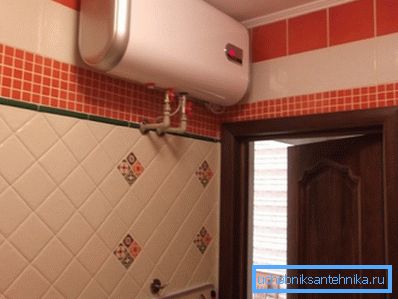
- The vertical tank is suitable for placement without an acute shortage of space.
Electric power
How to choose a heater for power?
For flow:
- 3.5 kW, as I wrote above, allow you to take a shower in the warm season without much comfort. To reduce water consumption (and, accordingly, to increase its temperature) they are equipped with a watering can with reduced nozzles;
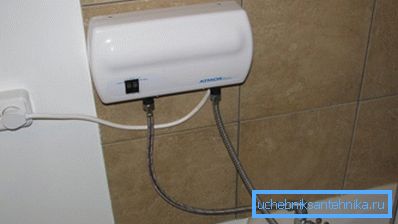
- 5 kW gives the opportunity to use a conventional watering can with a limited water pressure;
Note: too small a pressure will cause the heater to turn off during operation. All modern devices are equipped with pressure sensors, stopping the power supply to the heating elements at a pressure of 0.3 kgf / cm2 or less.
- 7 kW - this is an opportunity to take a shower or wash the dishes with complete comfort.
For the boiler, the picture is somewhat different. Typically, the power device lies in the range of 1 - 2.4 kW, which allows you to connect it to a regular outlet. The greater the volume of the tank, the greater the power of heating elements forced to use manufacturers: its increase reduces the time of heating water to operating temperature.
A reasonable balance between the load on the wiring and the heating rate is provided by boilers with fast heating - an additional heater that is activated manually. They can be used to quickly prepare a new portion of hot water after emptying the tank; Usually the boiler works in economy mode.
Volume of the tank
What amount of boiler to choose for 2 people, for 3 and so on?
I would advise to proceed from a minimum volume of 40 liters for each family member. This volume will give the opportunity to take a shower to several people with a minimum break, without waiting for the tank to re-heat. Thus, for two people a 80 liter boiler is bought, for 3 - 120 and so on.
We should also mention the boilers for the kitchen. For a comfortable dishwashing in a small family, a volume of 15 liters is enough. Such a boiler can fit in a cabinet under the sink.
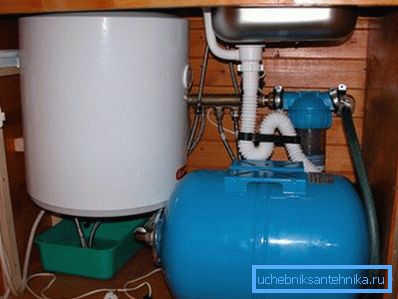
A pair of small tricks related to the volume of the tank.
- Throttling liner before sink mixers will dramatically reduce water consumption (including hot). The fact is that taps often open much more than is necessary for washing and washing dishes. Throttles or half-open ball valves (yes, I know that for them this is an abnormal mode) will limit the pressure;
- The higher the DHW temperature, the greater the volume of water with a comfortable temperature that can be obtained with a fixed volume of the tank.
However: an increase in temperature entails increased heat loss through the insulation of the tank. The greater the delta temperature between the water and the air in the room, the greater the heat flow through the boundary between the media.
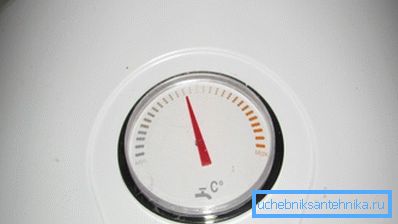
Tank material
Low-cost boilers are usually equipped with a steel tank, covered inside with enamel or glass-ceramic. The disadvantage of these coatings is that they do not tolerate temperature drops.
When the boiler starts to fill up with cold water at the flow of boiling water, they give microcracks, which later cause through tank corrosion and leaks.
Stainless steel tanks are completely devoid of this drawback and are practically eternal in the absence of weld defects.
Anode
The presence of a magnesium anode slows down electrochemical corrosion of a black steel tank: it becomes a source of electrons, which otherwise would have been pulled out of the walls of the boiler. The presence of the anode actually increases the service life of the boiler. Alas, it is completely dissolved in 5 - 7 years of operation and requires periodic replacement.
Dry TEN
TEN, placed in a water-contacting flask, does not overgrow with scum and does not fail when overheated. Another advantage of it is the possibility of hot-swapping without draining the water from the tank. On the other hand, most of the failures of low-cost boilers are not connected with scale and the output of heating elements, but with the depressurization of the tank, so with a significant difference in price with submersible dry heating elements can hardly be recommended as an advantage.
Installation
Flow through
The simplest wiring diagram for a 3.5 kW flow heater is:
- The power cord connects to a fixed outlet;
Warning: do not use extension cords for connection. A typical inexpensive extension cable has a 0.75 wire cross section, at best 1 mm2. With a load of 3.5 KW, overheating of this wire is guaranteed; melting the insulation will cause a short circuit and fire.

- At the faucet, the shower head is unscrewed from the hose;
- The shower hose connects to the heater inlet;
- The standard shower hose of the appliance with its own watering can is screwed onto the outlet. The heater can be turned on and used for its intended purpose.
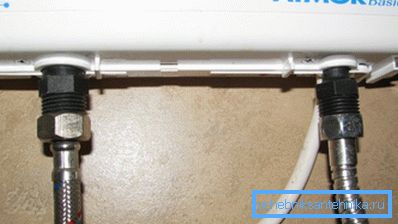

With a power of 5 - 7 kW, the heater is connected only directly to the electrical panel and only with a separate wire. The copper wire cross-section is calculated on the basis of a current of 8–10 amps per square millimeter (2 mm2 for 3.5 KW and 4 mm2 for 7 KW).
With a power above 7 kW the device is connected only to the mains of 380 volts.
In-Line devices are connected to the water line break; you can use both rigid and flexible eyeliner. With increased pressure at the inlet of the pipeline (for example, in the presence of a powerful centralized pumping), a pressure reducer is placed in front of the heater. The safety valve is usually part of the device design.
Accumulative
Boiler is strongly recommended to mount on hard liners.
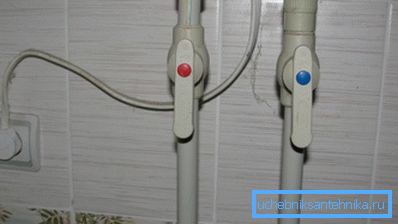
Before the storage water heater are mounted:
- With increased pressure in the water supply system - a reducer;
- Check valve It does not allow water to drain into the water supply system and leave the heating element dry when cold water is turned off;
- A safety valve that discharges water when the pressure in the circuit is exceeded due to its thermal expansion.
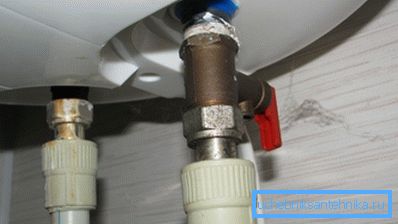
Conclusion
I hope that my review of the existing market offers will help the respected reader to make a successful purchase. As always, additional thematic materials can be studied by viewing the video in this article. I would appreciate your comments and additions. Successes, comrades!